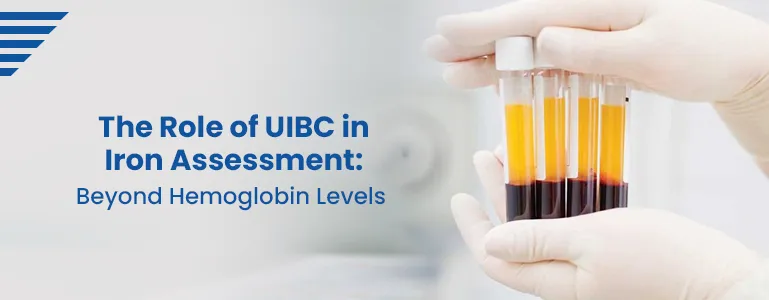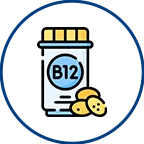The Role of UIBC in Iron Assessment: Beyond Hemoglobin Levels

When discussing iron health, hemoglobin levels often take center stage. However, there's another vital player in the iron assessment game: Unsaturated Iron-Binding Capacity (UIBC). In this blog, we'll explore the significance of UIBC in evaluating iron status, its relationship with other iron markers, and how a comprehensive understanding goes beyond hemoglobin to paint a more accurate picture of iron health.
Unpacking UIBC
UIBC refers to the capacity of transferrin, a protein that transports iron, to bind with additional iron. In simpler terms, it represents the available "slots" on transferrin to carry iron molecules. Unlike iron saturation, which assesses the occupied slots, UIBC measures the unoccupied ones.
Home Sample Collection
Complementing Hemoglobin Analysis
While hemoglobin is a crucial indicator of iron deficiency anemia, relying solely on it can miss early iron deficiency stages. UIBC, alongside other markers like serum iron and total iron-binding capacity (TIBC), offers a more comprehensive view.
What UIBC Reveals
UIBC's value lies in its ability to help diagnose various iron disorders. Elevated UIBC might suggest iron deficiency, while low UIBC could indicate inflammation or chronic disease. When paired with other markers, it aids in distinguishing different types of anemias and identifying the underlying causes.
Iron Saturation vs. UIBC
Iron saturation and UIBC are like two sides of a coin. Iron saturation calculates the percentage of transferrin slots occupied by iron, while UIBC indicates the percentage that's still available. A high UIBC and low iron saturation can indicate iron deficiency, even if hemoglobin levels are within range.
Clinical Utility
UIBC's clinical relevance extends beyond diagnosis. It helps healthcare providers tailor treatment plans for patients. For instance, identifying whether low iron is due to poor absorption or chronic disease aids in determining the most effective interventions.
Interpreting UIBC Trends
Monitoring UIBC trends over time is essential. A consistently declining UIBC might indicate improving iron status, while a persistent rise could point to worsening deficiency. This dynamic perspective adds depth to the iron assessment process.
Holistic Iron Health
In the realm of iron assessment, UIBC acts as a detective, uncovering clues that other markers might overlook. By integrating UIBC analysis into the evaluation process, healthcare professionals gain a more comprehensive understanding of a patient's iron health, allowing for tailored and timely interventions.
Conclusion
While hemoglobin remains a vital player in iron assessment, the role of UIBC is equally crucial. This unsung hero offers insights beyond occupancy levels, revealing iron's intricate dance within the body. By recognizing UIBC's significance, healthcare providers can more accurately diagnose iron disorders and provide effective care that goes beyond surface-level indicators.
Frequently Asked Questions
What is UIBC, and how does it relate to iron assessment?
Unsaturated Iron-Binding Capacity (UIBC) measures the amount of transferrin's available capacity to bind with iron. It plays a crucial role in evaluating iron levels beyond just hemoglobin.
How does UIBC complement the assessment of iron health?
While hemoglobin is an essential marker, relying solely on it can miss early iron deficiency stages. UIBC, along with other markers like serum iron and total iron-binding capacity (TIBC), offers a more comprehensive view of iron status.
What insights does UIBC provide that other markers might miss?
UIBC helps diagnose various iron disorders by indicating iron deficiency or inflammation. It aids in distinguishing different types of anemias and identifying underlying causes.
How does UIBC differ from iron saturation?
Iron saturation calculates the percentage of transferrin slots occupied by iron, while UIBC indicates the percentage available. A high UIBC and low iron saturation might suggest iron deficiency, even if hemoglobin levels are normal.
Why is monitoring UIBC trends important?
Tracking UIBC trends over time is crucial for assessing iron health. A consistent decrease might indicate improving iron status, while an increase could suggest worsening deficiency, providing insights for timely interventions.
How does understanding UIBC contribute to tailored treatment plans?
UIBC helps healthcare providers determine whether low iron is due to poor absorption or chronic disease. This knowledge guides the selection of the most effective interventions for individual patients.
Is UIBC analysis part of routine iron assessment?
UIBC analysis is an essential component of comprehensive iron assessment, particularly when diagnosing iron disorders or evaluating chronic conditions. It contributes to a holistic understanding of a patient's iron health beyond surface-level indicators.
Book Your Slot
Our Locations Near You in Hyderabad
3KM from Banjara Hills
1.9KM from Yusufguda
3KM from Madhura Nagar
5KM from Shaikpet
Profiles
- Cardiac Risk Profile
- Pituitary marker Profile
- Rheumatoid Arthritis Profile
- Dengue Fever Panel
- Lung Cancer Panel 1 Complete Molecular
- Gastroenteritis Screening Panel
- Thyroid Profile (T3,T4,TSH), Serum
- Pancreatic Marker Profile
- STD profile
- Androgen Profile
- Lipid Profile, Serum
- Pancreatic(acute)Profile
- PCOD Profile
Radiology
Pathology Tests
- Glucose Fasting (FBS),Sodium Fluoride Plasma
- Creatinine, Serum
- Glycosylated Hemoglobin (HbA1C)
- Vitamin B12 (Cyanocobalamin), Serum
- Thyroid Stimulating Hormone (TSH) Ultrasensitive, Serum
- Complete Urine Examination (CUE), Urine
- Liver Function Test (LFT),Serum
- Dengue (IgG & IgM), Serum
- Dengue Antigen (Ns1) Rapid, Serum
- C-Reactive Protein (CRP), Serum
- Widal (Slide Method), Serum
- Total IgE, Serum




